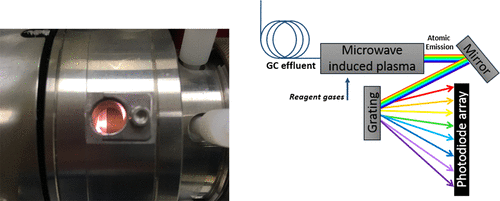当前位置:
X-MOL 学术
›
ACS Earth Space Chem.
›
论文详情
Our official English website, www.x-mol.net, welcomes your
feedback! (Note: you will need to create a separate account there.)
Direct Measurement of Elemental Mercury Using Multidimensional Gas Chromatography with Microwave-Induced Helium Plasma Atomic Emission Spectroscopy
ACS Earth and Space Chemistry ( IF 2.9 ) Pub Date : 2018-04-13 00:00:00 , DOI: 10.1021/acsearthspacechem.8b00008 Ronda Gras 1 , Jim Luong 1 , Robert A. Shellie 2
ACS Earth and Space Chemistry ( IF 2.9 ) Pub Date : 2018-04-13 00:00:00 , DOI: 10.1021/acsearthspacechem.8b00008 Ronda Gras 1 , Jim Luong 1 , Robert A. Shellie 2
Affiliation

|
Microwave-induced helium plasma atomic emission spectroscopy permits direct measurement of picogram levels of elemental mercury in various matrices when combined with multidimensional gas chromatography. Two columns with different stationary phases provide excellent separation for elemental mercury, and multidimensional analysis improves the reliability, performance, and system cleanliness of atomic emission detection. The possibility of false positive identification is substantially eliminated, and excellent sensitivity for the target compound was attained with the use of two selective columns and atomic emission detection at 254 nm. A flame ionization detector was incorporated as part of the system configuration to increase analytical platform capability and flexibility. Elemental mercury was measured in gas matrices over a range of 0.1–170 μg/m3 having a correlation coefficient of R2 = 0.9995, a precision of less than 5% relative standard deviation (n = 10), and a measured recovery exceeding 99% in natural gas as a model matrix. The total analysis time is less than 10 min. Only a small 1 mL sample volume is needed, and the described approach does not rely on any form of sample enrichment. The utility of multidimensional gas chromatography with microwave-induced helium plasma atomic emission spectroscopy is demonstrated with challenging industrial applications, such as the measurement of elemental mercury in natural gas, industrial solvents, and vapor generated from ruptured compact fluorescent light bulbs.
中文翻译:

多维气相色谱-微波诱导氦等离子体原子发射光谱法直接测量元素汞
与多维气相色谱法结合使用时,微波诱导的氦等离子体原子发射光谱法可以直接测量各种基质中元素汞的皮克含量。具有不同固定相的两根色谱柱提供了极佳的元素汞分离效果,多维分析提高了原子发射检测的可靠性,性能和系统清洁度。基本上消除了假阳性识别的可能性,并且通过使用两个选择性色谱柱和在254 nm处的原子发射检测,获得了对目标化合物的出色灵敏度。火焰离子检测器作为系统配置的一部分并入,以提高分析平台的功能和灵活性。气体基质中的元素汞测量范围为0.1–170μg/ m3具有相关系数R 2 = 0.9995,精度小于5%的相对标准偏差(n = 10),并且在天然气中作为模型矩阵的测量回收率超过99%。总分析时间少于10分钟。仅需要少量的1 mL样品,并且所描述的方法不依赖于任何形式的样品富集。具有微波诱导氦等离子体原子发射光谱法的多维气相色谱的实用性在具有挑战性的工业应用中得到了证明,例如,天然气,工业溶剂中的元素汞的测量以及紧凑型荧光灯泡破裂产生的蒸汽的测量。
更新日期:2018-04-13
中文翻译:

多维气相色谱-微波诱导氦等离子体原子发射光谱法直接测量元素汞
与多维气相色谱法结合使用时,微波诱导的氦等离子体原子发射光谱法可以直接测量各种基质中元素汞的皮克含量。具有不同固定相的两根色谱柱提供了极佳的元素汞分离效果,多维分析提高了原子发射检测的可靠性,性能和系统清洁度。基本上消除了假阳性识别的可能性,并且通过使用两个选择性色谱柱和在254 nm处的原子发射检测,获得了对目标化合物的出色灵敏度。火焰离子检测器作为系统配置的一部分并入,以提高分析平台的功能和灵活性。气体基质中的元素汞测量范围为0.1–170μg/ m3具有相关系数R 2 = 0.9995,精度小于5%的相对标准偏差(n = 10),并且在天然气中作为模型矩阵的测量回收率超过99%。总分析时间少于10分钟。仅需要少量的1 mL样品,并且所描述的方法不依赖于任何形式的样品富集。具有微波诱导氦等离子体原子发射光谱法的多维气相色谱的实用性在具有挑战性的工业应用中得到了证明,例如,天然气,工业溶剂中的元素汞的测量以及紧凑型荧光灯泡破裂产生的蒸汽的测量。











































 京公网安备 11010802027423号
京公网安备 11010802027423号